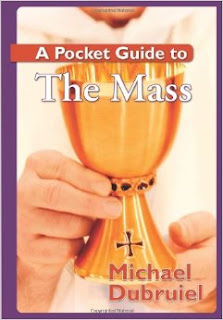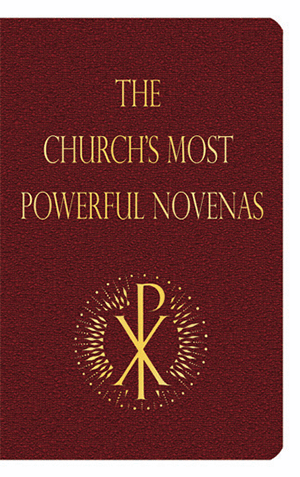Tuesday of the First Week of Advent
Tuesday, November 30, 2021
Daily Advent Devotional by Michael Dubruiel
Monday, November 29, 2021
Daily Advent Meditation - Monday First Week of Advent
These were written by Michael Dubruiel many years ago.
Sunday, November 28, 2021
First Sunday of Advent Reflection
These were written by Michael Dubruiel many years ago.
Saturday, November 27, 2021
Traveling to Rome
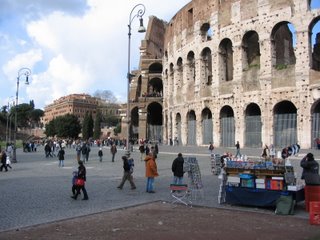
From Michael Dubruiel 2006
The scavi tours completed, it was time to head to the Roman Forum. We took the bus to the Termini and then caught the Metro train to the Coloseum. The station lets you out right at the Coloseum and its quite a sight. I'll admit to being a little tired at this point (even as I write this several weeks afterwards). There were a number of people offering tours in English, we hooked up with one who then purchased the tickets for us, charging 6 euro extra for the tour, but by doing this there was no wait in a line and after a short wait we were inside.
The Coloseum is one of those sites that before the papacy of Pope John Paul (this is my recollection anyway and it is certianly effected by what we see of papal ceremonies on television) I wouldn't have thought of as a religious site. Even the tour guide who was Italian and spoke English with great force as though every phrase she spoke was a command rather than information pointed out almost immediately that the wooden cross that is central to the Coloseum "that!" she said loudly "is not original!" "It was put there by Pope John Paul the Second!" I believe that Pope John Paul reclaimed this site of martyrdoms for Christianity in the same way that pontiffs before him had done.
The tour guide was very entertaining, she sang the glories of Roman workmanship, their ability to create a structure that would be difficult to recreate today. With her flag she pointed out "original!" and "not original!" Other parts of her presentation were dramatic recreations of the events that would have transpired on this spot, sometimes aided by her illustrated guidebook.
 In the picture you'll notice the book, and the flag and if you look dead center (click on the picture to enlarge it might aid you in this exercise) you'll see the cross dead center erected by Pope John Paul II ("not original!"). This is the day that discovering that I had 1500 pictures remaining on my camera decided to start taking lots of pictures, which is a help in remembering what we did on this day as well as indicting me for taking so few earlier in the week.
In the picture you'll notice the book, and the flag and if you look dead center (click on the picture to enlarge it might aid you in this exercise) you'll see the cross dead center erected by Pope John Paul II ("not original!"). This is the day that discovering that I had 1500 pictures remaining on my camera decided to start taking lots of pictures, which is a help in remembering what we did on this day as well as indicting me for taking so few earlier in the week.Back to the tour, it was brief--around 30 minutes and then we were told to meet at a certian spot in about an hour for the continuation of the tour of the Palantine hill. So we walked around, and up to the upper levels of the Coloseum. It is easy to be caught up in the magnificent structure and to forget that on this spot lives were sacrificed for entertainment. One of the dramatic enactments of the tour was when the tour guide said with great gusto first in Latin and then in her command English "Hail, Caesar! We, who are about to die, salute you" and then extended her hand toward the Emperor that evoked the Nazi salute to Hitler. The martyrs who died here saluted another, the real God and changed the city of Rome and the Empire that was the Roman. Other Caesar's continue to arise demanding the lives of their followers in exchange for whatever temporal kingdom. Looking down at the ruins of the Coloseum, patched up and being held together by reinforcements of one type or another--the Cross erected by Pope John Paul II speaks to the victory over innocent suffering of countless victims of the false god's of wealth, pleasure and youth.

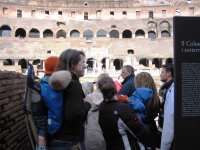

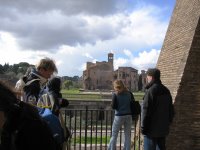 The tour guide had actually begun her tour outside of the Coloseum pointing out the Arch of Constantine, perhaps another symbol of the victory over Christianity since it marks the victory of Constantine that was later attributed to his vision of the Cross of Christ as the way to victory. There is nothing particularly Christian about the arch and the tour guide pointed out that "this is original" and that in Paris and Berlin you'll find copies that are larger (and perhaps now more famous).
The tour guide had actually begun her tour outside of the Coloseum pointing out the Arch of Constantine, perhaps another symbol of the victory over Christianity since it marks the victory of Constantine that was later attributed to his vision of the Cross of Christ as the way to victory. There is nothing particularly Christian about the arch and the tour guide pointed out that "this is original" and that in Paris and Berlin you'll find copies that are larger (and perhaps now more famous).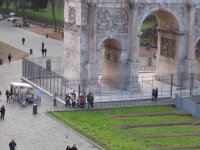
Coming out of the Coloseum, we decided against the tour of the Palantine Hill, opting instead to go through the Forum. As we made our way in that direction while trying to steer Joseph away from a newstand I was attacked by one of the Roman's in the garb of a gladiator with his sword--this was unexpected and I probably jumped a foot or two. Joseph said, "I'll fight him" but when another approached from another direction he moved around so that if this one "sworded me" he wouldn't get hurt--so much for courage.
We made our way up the via sacra and began fumbling in our tour books trying to find where we were and what everything we were seeing was (some of this must have been fatigue because I have some of those tour books open before me now and everything is so clear and understandable that I can't figure out how we could have been confused then but we were and not alone in that regard). While we sat by the Basilica of
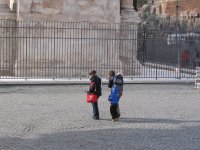 Constantine and Maxentius (not knowing it was that at the time)another family approached us and asked us if we knew what this was, we didn't. Some were from Cincinnati and one man a doctor said that he would be giving a talk in Fort Wayne the day after we returned...small world.
Constantine and Maxentius (not knowing it was that at the time)another family approached us and asked us if we knew what this was, we didn't. Some were from Cincinnati and one man a doctor said that he would be giving a talk in Fort Wayne the day after we returned...small world.Another problem at this point was we were right outside of the Church of St. Frances of Rome and there didn't seem to be anyway to get into it. Her feast was last Thursday (March 9) and when I read the Office of Readings for her feast I was disappointed that we never made it into this church were she rests.
Moving on from the amazing ruins of the Basilica of Constantine we made our way into the heart of the Forum. For the most part you can just look at the ruins (if these had been made into Churches you might actually be able to enter them as you can the Roman Senate). The Temple of Julius Ceasar marking the spot where he was cremated was interesting (I had viewed HBO's Rome last winter) and there was a fresh rose on the stone marking the spot.Here are a few pictures of this spot, in the second and third you can see the Temple of Antoninus and Faustina in the background.In the fourth we continue along our way, notice the baby must be back on my back since he isn't with the other three.There are a lot of pilars in the Forum area and they cast a long shadow, especially when the sun is laying low in the sky. Here Joseph finds a contest of shadows with three pilars (from the Temple of Vespasian) and Katie finds that fallen pilars make a good seat. Joseph uses another pilar to form his
own "Arch of Triumph."The Temple of Saturn was illuminated by the sun, Joseph felt the need to offer ablutions, Amy outside of Santi Luca e Martina (site of the Roman Senate) and the crew emerging from the same Church bathed in sunlight.

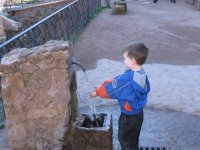
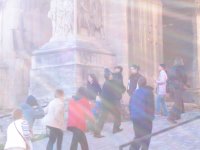
Friday, November 26, 2021
When is the first Sunday of Advent?
![Be Vigilant: Daily Meditations for Advent by [Dubruiel, Michael, Welborn, Amy]](https://images-na.ssl-images-amazon.com/images/I/41XuPOPRwcL.jpg)
Advent begins November 28, 2021
Thursday, November 25, 2021
Thanksgiving Meditation
This is the season during which many people think of charitable acts.
The genesis of this book was inspired by a set of talks that Father Benedict J. Groeschel C.F.R., gave several years ago in the Diocese of Manchester, NH. At the time while researching material for a project I was working on I came across an advertisement for the talks and found both the title and topic striking. The topic seemed to fit Father Benedict's lifetime of working among the poor and raising money to help their plight. I approached him, shortly after listening to the tapes and asked him to consider doing a book version. He liked the idea but was reluctant to pursue the project alone due to the shortage of time available to work on it.
Unwilling to let go of the project, I approached another friend of the poor, Bishop Robert J. Baker of the Diocese of Charleston. I knew that Bishop Baker's priestly ministry had been devoted to finding Christ in the poor and with a wealth of experience he had in this area that if I could join his thoughts with Fr. Groeschel' s we would have a book that would be of great benefit to the rest of us. After approaching Bishop Baker with my request he agreed and then Father Benedict agreed to collaborate on this book.
While the Bishop and Father Benedict were working on the written text of the book I came across a stunning work of iconography one day while visiting an Eastern Catholic church. On the back wall of the church was an icon of the Last Judgment taken from Matthew 25. I found that the great iconographer Mila Mina had written the icon. I immediately contacted Mila and asked if the icon might be used as an illustration for this book, her response was "anything to make the Gospel known!" Thanks to Mila and her son Father John Mina for allowing Joyce Duriga and David Renz to photograph the icon at Ascension of Our Lord Byzantine Catholic Church, Clairton, PA.
Fr. Groeschel has written the introductory text that begins each section as well as the final "What Should I Do?" at the end of the book, and Bishop Baker has written the individual meditations and prayers contained in each of the six sections.
While this book was being written, Father Benedict was involved in a horrific accident that nearly took his life. At the time of the accident the text he was working on was in his suitcase. He had just finished the introduction to "When I was a stranger..." as you read over the text for that section you might sense that he was having a premonition of what was about to happen in his life-where he would soon be in an emergency room under the care of doctors, nurses and as well as his family and religious community.
You will find that this book provides you with keys to finding Our Lord in the poor, and to overcoming the fears and obstacles (represented by the seven deadly sins in each section) that prevent you from responding to His call.
Wednesday, November 24, 2021
Pilgrimage to Rome
From February 2006, by Michael Dubruiel
On Saturday, February 25th we arrived in Rome. Our landlord was waiting for us at our apartment and did a quick run through of how everything in the ample dwelling functioned. One thing he forgot to tell us was how to operate the satelite television (which turned out to be a blessing for us).
Anxious to see St. Peter's we left our suitcases and headed in that direction, only two blocks away. My first thought as we stepped into the square was that it looked small. Its not small by any stretch of the imagination but it looks small in person. This was something that I experienced time and time again within St. Peter's and is a testament to how well the architects of this structure mastered proportionalism. Things are gigantic, but appear intimate.
Another surprise was the long line to enter the Church. It seemed like it would take hours to enter, but I said to everyone we didn't come here just to stand in the sqaure. We got in line and within a few minutes were near the front of the line. It moved quickly.
Walking into the church we were stopped (we actually had walked into the wrong entrance, I figured this out after the first day), it turned out we were in the line for the crypt where Pope John Paul II was recently buried. They were only letting a certian number of people go down at a time, so we waited a few minutes and looked at the Holy Year doors.
Finally we made our way into the crypt. We went through several rooms before arriving where the pope's are buried. We passed a niche where Pope Paul VI rests, Pope John Paul I's tomb is in the hall. There was a crowd around the spot where Pope John Paul II rests. I would visit this spot everyday of my time in Rome and pray for many who came to mind--it seemed quite natural to do so.
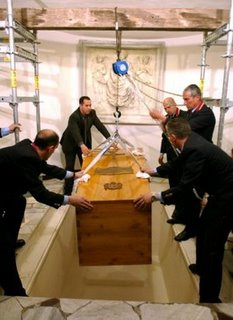 Flowers were scattered on the tomb, some pictures, some prayer requests. A guard moved everyone along, motioning to a space against the wall if someone wished to remain there in prayer.
Flowers were scattered on the tomb, some pictures, some prayer requests. A guard moved everyone along, motioning to a space against the wall if someone wished to remain there in prayer.Just past the tomb of John Paul is the center of St. Peter's--the tomb of the Apostle in the Confessio. I'm not sure if most of those walking through the Basilica understood this--most seemed to walk by without giving a glance behind the glass wall. The path took us right past other tombs and eventually outside of the church. We were a little (actually a lot) confused because we hadn't actually gone into the Basilica yet.
We went back up the stairs toward the front and through the central doors and this time entered the largest Church in the world. It looks so familar, yet to see it all at one time gave me a different view of the common site. The bodies of incorrupt popes under the many altars, the massive papal monuments that seem to jut out from the walls. It almost seemed to be too much!
Midway down the nave to the right was a curtianed room. Guards stopped the casual tourists from entering a space that a sign marked as being for prayer. With the baby strapped to my back, I went in. The others, I supposed were scared off by the guard and the sign.
Inside a number of people were praying before the Blessed Sacrament exposed in a monstrance. I gave thanks to God for a safe trip and that our feet had finally settled here in the center of his Church. My rambling went on when Michael (the baby) who had been very quiet spoke.
He said a word that I'd never heard him say before "Christ". It was very clear, and simple, and he only spoke it once. I said a few more prayers and he was silent, then I left the Chapel, emerging back into the nave of St. Peter's.
It was then that I started to wonder about his little confession of faith, made in Rome in the large church dedicated to St. Peter who had once been asked by Jesus, "Who do men say that I am?"..."Some say Elijah, some say John the Baptist,"..."But you, who do you say that I am?"..."You are the Christ!"
Peter's confession on the lips of my 15 month old son in the presence of Christ in the Blessed Sacrament, so began my time in Rome.
Tuesday, November 23, 2021
Pilgrimage in Rome
From February 2006, by Michael Dubruiel
I arose early on Sunday and set out to St. Peter's by myself to arrive there when the church opened to the public at 7:00 A.M.. This was to become my daily ritual while I was in Rome and led to a number of unique experiences. Saint Peter's in the early morning is quite different from the way one experiences it later in the day. First, it is easy to enter with there usually being no line at the security check point. Secondly, much of what is closed to the public later in the day is open at this time of the morning. With each visit, I was to discover more and more of the Church.
This first morning I walked into the Church for the second time and was still trying to orient myself to it. I stood before Michaelangelo's Pieta by myself (later in the day you are lucky if you can get anywhere near the front of the glass panel). I walked down the center of the church and looked at the inscriptions showing where other large churches of the world would end in comparison to this Basilica.
Then I encountered an image from the past. Priests vested in green, all with their backs to me at the many side altars were offering Mass in the new rite in the old way. As I would walk by a different language would greet me. French at this altar, Italian here, German here, Spanish here and English at yet another altar. On this Sunday morning a large group of was gathering to process to one of the altars (I think it was the altar of Pope St. Leo the Great)--these were the Heralds of the Gospel. Present in the procession were both the male and female members and their beautiful chanting filled St. Peter's that early morning.
Since I was planning on attending mass later with the family, I did not participate in any of the Masses that morning but settled into the Blessed Sacrament chapel and prayed the office and the rosary. But on subsequent mornings I was to have some great experiences in early morning St. Peter's.
On the way back to rouse the family, I stopped in at a coffee bar to pick up some pastries and to have an expresso. I ordered un caffe and was met with the familiar response "Americano or expresso?" always giving me the sense that however I was asking it was a dead giveaway that I wasn't Italian. In fact throughout my time in Rome people would address me before I opened my mouth in English, as an American--so I must look like a typical American.
After the pastry consumption it was back to St. Peter's square to meet up with Charleston, South Carolina seminarian Jeffrey Kirby who is in Rome attending the North American College. Through my friend the Bishop of Charleston we had arranged for Jeffrey to give us tour of St. Peter's and he did a marvelous job of filling in the blanks that my first two unattended visits had already raised.
One question I had involved St. Peter's square. Is there a marker where Pope John Paul II was shot? Jeff informed us that in fact one pavement stone had originally been removed after the incident because it contained a drop of blood from the Pontiff and it had been replaced with a red porphyry stone. He pointed to the general direction where this stone was in the square but it would be until Friday before I would actually see it.
After Jeffrey's excellent tour we went back to the apartment for a few minutes, before heading back to St. Peter's square for Pope Benedict's Angelus. There were some Polish nuns in front of us and after the Pope's address I greeted one of them in Polish saying in "Praised be Jesus Christ!" She responded in great enthusiasm and started talk rapidly in Polish to which I had to tell her that I had pretty much exhuasted my Polish in that one phrase.
A short walk out of the square and we attended Sunday Mass in Italian at Santo Spiritu, a Church that seemed to have a special designation as a "Divine Mercy" church.
Monday, November 22, 2021
Rome Pilgrimage
From February 2006, by Michael Dubruiel
On Saturday, February 25th we arrived in Rome. Our landlord was waiting for us at our apartment and did a quick run through of how everything in the ample dwelling functioned. One thing he forgot to tell us was how to operate the satelite television (which turned out to be a blessing for us).
Anxious to see St. Peter's we left our suitcases and headed in that direction, only two blocks away. My first thought as we stepped into the square was that it looked small. Its not small by any stretch of the imagination but it looks small in person. This was something that I experienced time and time again within St. Peter's and is a testament to how well the architects of this structure mastered proportionalism. Things are gigantic, but appear intimate.
Another surprise was the long line to enter the Church. It seemed like it would take hours to enter, but I said to everyone we didn't come here just to stand in the sqaure. We got in line and within a few minutes were near the front of the line. It moved quickly.
Walking into the church we were stopped (we actually had walked into the wrong entrance, I figured this out after the first day), it turned out we were in the line for the crypt where Pope John Paul II was recently buried. They were only letting a certian number of people go down at a time, so we waited a few minutes and looked at the Holy Year doors.
Finally we made our way into the crypt. We went through several rooms before arriving where the pope's are buried. We passed a niche where Pope Paul VI rests, Pope John Paul I's tomb is in the hall. There was a crowd around the spot where Pope John Paul II rests. I would visit this spot everyday of my time in Rome and pray for many who came to mind--it seemed quite natural to do so.
 Flowers were scattered on the tomb, some pictures, some prayer requests. A guard moved everyone along, motioning to a space against the wall if someone wished to remain there in prayer.
Flowers were scattered on the tomb, some pictures, some prayer requests. A guard moved everyone along, motioning to a space against the wall if someone wished to remain there in prayer.Just past the tomb of John Paul is the center of St. Peter's--the tomb of the Apostle in the Confessio. I'm not sure if most of those walking through the Basilica understood this--most seemed to walk by without giving a glance behind the glass wall. The path took us right past other tombs and eventually outside of the church. We were a little (actually a lot) confused because we hadn't actually gone into the Basilica yet.
We went back up the stairs toward the front and through the central doors and this time entered the largest Church in the world. It looks so familar, yet to see it all at one time gave me a different view of the common site. The bodies of incorrupt popes under the many altars, the massive papal monuments that seem to jut out from the walls. It almost seemed to be too much!
Midway down the nave to the right was a curtianed room. Guards stopped the casual tourists from entering a space that a sign marked as being for prayer. With the baby strapped to my back, I went in. The others, I supposed were scared off by the guard and the sign.
Inside a number of people were praying before the Blessed Sacrament exposed in a monstrance. I gave thanks to God for a safe trip and that our feet had finally settled here in the center of his Church. My rambling went on when Michael (the baby) who had been very quiet spoke.
He said a word that I'd never heard him say before "Christ". It was very clear, and simple, and he only spoke it once. I said a few more prayers and he was silent, then I left the Chapel, emerging back into the nave of St. Peter's.
It was then that I started to wonder about his little confession of faith, made in Rome in the large church dedicated to St. Peter who had once been asked by Jesus, "Who do men say that I am?"..."Some say Elijah, some say John the Baptist,"..."But you, who do you say that I am?"..."You are the Christ!"
Peter's confession on the lips of my 15 month old son in the presence of Christ in the Blessed Sacrament, so began my time in Rome.
Sunday, November 21, 2021
Advent Begins November 28
![Be Vigilant: Daily Meditations for Advent by [Dubruiel, Michael, Welborn, Amy]](https://images-na.ssl-images-amazon.com/images/I/41XuPOPRwcL.jpg)
Saturday, November 20, 2021
RCIA Guide to the Mass
In this complete guide you get:
- step-by-step guidelines to walk you through the Mass
- the Biblical roots of the various parts of the Mass and the very prayers themselves
- helpful hints and insights from the Tradition of the Church
- aids in overcoming distractions at Mass
- ways to make every Mass a way to grow in your relationship with Jesus
- Bless yourself
- Make the Sign of the Cross
- Genuflect
- Pray before Mass
- Join in Singing the Opening Hymn
- Be penitential
- Listen to the Scriptures
- Hear a Great Homily Everytime
- Intercede for others
- Be a Good Steward
- Give Thanks to God
- Give the Sign of Peace
- Receive the Eucharist
- Receive a Blessing
- Evangelize Others
- Get something Out of Every Mass You Attend
Find more about The How to Book of the Mass here.
Friday, November 19, 2021
Feast of the North American Martyrs- November 19
Today is the Feast of St. Isaac Jogues and North American Jesuit Martyrs. I spent one month of my life living at the Shrine of the North American Martyrs in Auriesville, NY making a 30 day retreat in 1992. A month of silence and vivid dreams on the very land where Rene Groupil, John LaLande and Isaac Jogues were martyred. The dream I remember most was being chased by someone who had a hatchet in their hand. Read about St. Isaac Jogues and you can probably figure out where that came from. - Michael Dubruiel, originally published 10/19/01

Prayer of Petition
O God, who inflamed the hearts of your blessed Martyrs with an admirable zeal for the salvation of souls, grant me, I beseech you, my petions and all the requests recommended here today, (here name your request) so that the favours obtained through their intercession may make manifest before all the power and the glory of your name. Amen.
St. Jean de Brébeuf, pray for us.
St. Isaac Jogues, pray for us.
St. Gabriel Lalemant, pray for us.
St. Antoine Daniel, pray for us.
St. Charles Garnier, pray for us.
St. Noël Chabanel, pray for us.
St. René Goupil, pray for us.
St. Jean de Lalande, pray for us.
Holy Mary, Queen of Martyrs, pray for us.
Thursday, November 18, 2021
73 Steps to Communion with God 60b
This is a continuation of the 73 Steps to Communion with God by Michael Dubruiel. The previous steps appear throughout the Archives, available to the left. This is the 60th step, part 2:
(60) To hate one's own will:
To fight "our will" does not mean going off into another direction but rather facing reality. Our "will" often pulls us away from what most needs our attention. We often will to be somewhere other than where we are, to be doing something other than what needs to be done and to be with someone other than the one we are with at the present moment. These are exactly the moments when we are to "hate" our own will and seek to do the will of God.
Wednesday, November 17, 2021
73 Steps to Communion with God 60a
This is a continuation of the 73 Steps to Communion with God by Michael Dubruiel. The previous steps appear throughout the Archives, available to the left. This is the 60th step, part 1:
(60) To hate one's own will:
Someone who seeks to be in communion with God has to learn to subject themselves entirely to God's will. Jesus who was the Son of God still prayed in His humanity that "not his will be done but the Father's." We all have "our way" of looking at life and "our way" of doing things and the Scriptures are quite clear that "our way is not God's way."
We all suffer because we believe that happiness lies in fulfilling our will. But if we have the gift to reflect on our past, we quickly come to the realization that much of what we "will" does not bring us happiness and in fact is quite fleeting and arbitrary--changing with the wind.
Tuesday, November 16, 2021
Michael Dubruiel: 73 Steps to Communion with God 59b
This is a continuation of the 73 Steps to Communion with God by Michael Dubruiel. The previous steps appear throughout the Archives, available to the left. This is the 59th step part 2:
(59) Not to fulfil the desires of the flesh (cf Gal 5:16).
Contrast the works of the flesh with the desires of the Spirit: "But the fruit of the Spirit is love, joy, peace, patience, kindness, goodness, faithfulness, gentleness, self-control," (Galatians 5:22). Notice the first three are all what the "desires'" of the flesh are motivated by, the desire to experience love, joy and peace, but of course they never lead to that, so we should strive to live by the Spirit.
Monday, November 15, 2021
Michael Dubruiel: 73 Steps to Communion with God 59a
This is a continuation of the 73 Steps to Communion with God by Michael Dubruiel. The previous steps appear throughout the Archives, available to the left. This is the 59th step part 1:
(59) Not to fulfil the desires of the flesh (cf Gal 5:16).
This counsel of St. Benedict's is a quote from St. Paul's letter to the Galatians, "But I say, walk by the Spirit, and do not gratify the desires of the flesh," (Galatians 5:16). St. Paul saw the flesh and the Spirit at war with one another and one would suspect that so would St. Benedict. The flesh for Paul was an obstacle to being the person God had created us to be.
But less we project all of our own ideas about what the "flesh" means, let us look at what St. Paul means when he speaks about the "flesh": "Now the works of the flesh are plain: fornication, impurity, licentiousness, idolatry, sorcery, enmity, strife, jealousy, anger, selfishness, dissension, party spirit, envy, drunkenness, carousing, and the like. I warn you, as I warned you before, that those who do such things shall not inherit the kingdom of God," (Galatians 5:19-21). If one peruses the list one will find that the "desires" of the flesh are all the ways that our desires can go mad and lead to our own destruction.
Sunday, November 14, 2021
Michael Dubruiel: 73 Steps to Communion with God 58 Part 2
(58) To confess one's past sins to God daily in prayer with sighs and tears, and to amend them for the future.
I remember during a pilgrimage to Medjugordje in what is now Bosnia in the late 1980's standing in a confessional line and watching people emerge from the outside confessional stations (a chair with a priest, while the penitent knelt beside him) wiping tears away. It was touching, because it gave me the sense that these weren't just a listing off of faults but a heart felt conversion from a life without God to a life that the penitent truly wanted to live with the help of God. We should all pray for the gift of tears for our failings.
My great-grandfather would always be wiping tears away when he returned from receiving communion. I found this deeply significant as a child and it is something I've never forgotten. Involving our emotions in our relationship with God is a great grace that we should strive to have in our relationship with Him.
Saturday, November 13, 2021
St. Francis Cabrini - November 13
A novena to Mother Cabrini is included in The Church's Most Powerful Novenas by Michael Dubruiel
The Church's Most Powerful Novenas is a book of novenas connected with particular shrines. Michael Dubruiel wrote in the introduction to this book he compiled:
A novena to Mother Cabrini is included in the book
Friday, November 12, 2021
73 Steps to Communion with God 58 Part 1
This is a continuation of the 73 Steps to Communion with God. by Michael Dubruiel The previous steps appear throughout the Archives, available to the left. This is the 58th step: Part 1
(58) To confess one's past sins to God daily in prayer with sighs and tears, and to amend them for the future.
One of the areas of spirituality, which has been under attack for the past forty years, is the "emphasis on sinfulness" that seems to have dominated spirituality of all religions from the beginning of time. Those who have bought into this notion have found that after awhile God seems to slip further and further from the picture.
Sin essentially is anything that breaks my relationship with God. Remove sin from the picture and you are essentially removing God from the picture--because you are admitting that it really doesn't matter if you are offending God or not. It would be like being in a relationship with your spouse and refusing ever to admit any wrongdoing or to even consider that you are ever wrong (I've been accused of this before but I humbly submit that I am almost always wrong when it comes to my faults in my relationship with my wife), one would expect such a relationship to be in grave trouble.
Admitting that we are not living up to our part of the relationship is a healthy practice of constantly trying to stay in communion with God. Doing it with "sighs and tears" means that we are not just doing some per forma but rather are emotionally feeling what we are saying. St. Ignatius of Loyola would have retreatants pray for the gift of tears when they meditated on their sinfulness and this is a practice that should be restored.
Thursday, November 11, 2021
73 Steps to Communion with God 57b
This is a continuation of the 73 Steps to Communion with God by Michael Dubruiel.. The previous steps appear throughout the Archives, available to the left. This is the 57th step part 2:
(57) To apply one's self often to prayer.
To pray continually was an injunction of St. Paul to the Thessalonians, "pray constantly," (1 Thess. 5:17) and if we understand that prayer is communicating with God, we can see that there is nothing more important if we are to be in communion with God.
Every moment of our day is an opportunity for prayer. There is nothing that we do in life that can not be brought to God. But it is important also to set aside time where we are not active and God is the focus of our undivided attention. Ideally this will happen as least seven times a day. Traditionally this would be when we arise in the morning, in the mid-morning, at noon, in the mid-afternoon, in the evening, when we retire and in the middle of the night. Of course the last one, in the middle of the night may seem the hardest but if you find yourself awakened in the middle of the night-there is perhaps no time when you can give God more of your undivided attention. The early Fathers felt that in the night (vigils) the spirit world was more visible and there was less to distract us.
Wednesday, November 10, 2021
St. Leo the Great - November 10
I attended an early mass at St. Leo the Great's tomb one morning while in Rome and as I read the office of readings for today by him, I thought how death makes this even more apparent.
St. Leo, pray for us!
-Michael Dubruiel
From the Office of Readings:
Although the universal Church of God is constituted of distinct orders of.-Michael Dubruiel
members, still, in spite of the many parts of its holy body, the Church subsists
as an integral whole, just as the Apostle says: We are all one in Christ. No
difference in office is so great that anyone can be separated, through
lowliness, from the head. In the unity of faith and baptism, therefore, our
community is undivided. There is a common dignity, as the apostle Peter says in
these words: And you are built up as living stones into spiritual houses, a holy
priesthood, offering spiritual sacrifices which are acceptable to God through
Jesus Christ. And again: But you are a chosen people, a royal priesthood, a holy
nation, a people set apart. For all, regenerated in Christ, are made kings by
the sign of the cross; they are consecrated priests by the oil of the Holy
Spirit, so that beyond the special service of our ministry as priests, all
spiritual and mature Christians know that they are a royal race and are sharers
in the office of the priesthood. For what is more king-like than to find
yourself ruler over your body after having surrendered your soul to God? And
what is more priestly than to promise the Lord a pure conscience and to offer
him in love unblemished victims on the altar of one’s heart? Because, through
the grace of God, it is a deed accomplished universally on behalf of all, it is
altogether praiseworthy and in keeping with a religious attitude for you to
rejoice in this our day of consecration, to consider it a day when we are
especially honoured. For indeed one sacramental priesthood is celebrated
throughout the entire body of the Church. The oil which consecrates us has
richer effects in the higher grades, yet it is not sparingly given in the lower.
Sharing in this office, my dear brethren, we have solid ground for a common
rejoicing; yet there will be more genuine and excellent reason for joy if you do
not dwell on the thought of our unworthiness. It is more helpful and more
suitable to turn your thoughts to study the glory of the blessed apostle Peter.
We should celebrate this day above all in honour of him. He overflowed with
abundant riches from the very source of all graces, yet though he alone received
much, nothing was given over to him without his sharing it. The Word made flesh
lived among us, and in redeeming the whole human race, Christ gave himself
entirely
Tuesday, November 09, 2021
St. John Lateran - November 9
A visit to St. John Lateran, from 2006, by Michael Dubruiel:
After a quick lunch (pizza, what else?)we headed toward the Metro station to catch the A Train to St. John Lateran's to meet up with Zadok who had so generously agreed to give us a tour of two of Rome's greatest Churches. We were still pretty green when it comes to the whole Metro system and walked (rather than took a bus) to the station, so by the time we finally arrived we were late and Zadok was nowhere to be seen (at least not at the Metro station where Amy had thought he had said he was going to meet us). So Amy went out the other possible exits and Katie, Joseph, the baby (on my back) and I went a bit further and bought a bottle of water. When Amy came to say that he could not be found, we decided to go on further to the Church and see if he might have gone on there when we had not arrived on time. Sure enought there he was...
I should mention that at this point we had already walked quite a bit (given two treks through St. Peter's, a good half mile to the Metro and another two or three blocks from the Metro to St. John's) while we stood and listened to Zadok's interesting history of the surrounding landmarks, Joseph sat.
 And even looking at the front of the Church's pavement now, makes me tired to think about even walking that distance. Most people think that St. Peter's is the Cathedral Church of Rome, but it isn't--St. John Lateran's is. While the chair of Peter is in St. Peter's, the Bishop of Rome's chair is at St. John Lateran's and this is the central feature of the apse of the Church, now that I think of it in a similar way to the way that the Chair of Peter is in the apse of St. Peter's. When St. Francis of Assisi came to Rome to see the Pope, he came here to the Lateran and their are large statues of Francis and his crew directly across from St. John's that seem to be in communication with the large statues that are on the facade of St. John's.
And even looking at the front of the Church's pavement now, makes me tired to think about even walking that distance. Most people think that St. Peter's is the Cathedral Church of Rome, but it isn't--St. John Lateran's is. While the chair of Peter is in St. Peter's, the Bishop of Rome's chair is at St. John Lateran's and this is the central feature of the apse of the Church, now that I think of it in a similar way to the way that the Chair of Peter is in the apse of St. Peter's. When St. Francis of Assisi came to Rome to see the Pope, he came here to the Lateran and their are large statues of Francis and his crew directly across from St. John's that seem to be in communication with the large statues that are on the facade of St. John's.  After his election as pope last April, Pope Benedict XVI came here to the Lateran to be formally installed as the Bishop of Rome (ever wonder why the Bishop of Rome isn't an "archbishop"?).
After his election as pope last April, Pope Benedict XVI came here to the Lateran to be formally installed as the Bishop of Rome (ever wonder why the Bishop of Rome isn't an "archbishop"?).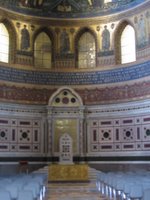
St John's has it's own Egyptian obelisk (just like St. Peter's) and a very impressive Baptistry which next to the Pope's chair is what I remember most about this part of our tour. The Baptistry was huge (I had seen one at the ruins of St. John's in Ephesus twenty-seven years earlier that was quite small in comparison). There was some type of festival going on outside of the Church that seemed to be a "Mardis Gras" or "Carnivale" type of celebration, remember this was just before the beginning of Lent. So next to the obelisk were booths, screaming kids and some people dressed in costumes giving the "pope's church" the feel of a regular parish back home.
Across the street we visited the Scala Santa--the holy stairs, said to have been brought to Rome by St. Helena the mother of Constantine and to have been the stairs that Jesus would have walked on during his Passion when he came before Pontius Pilate. The faithful climb up them on their knees and as this picture will attest--there were no shortage of takes on the day we were there, in fact there were so many that it was really impossible to get near the steps to see them.
We walked up the side steps to another chapel called the Holy of Holies because it contained many holy relics and an image of Christ reported to have been painted by St. Luke entitled "picture painted without hands"....any student of Catholic piety knows there are many images reported to have been painted by St. Luke (Our Lady of Czestochova being one example). I had never thought about it much before, but I wonder if another meaning might be that Luke's Gospel inspired the works? I doubt the people working their way up on their knees think so..
 Around the other side of the Holy Stairs was the remains of the Papal dining hall and an impressive mosaic, as we were viewing this site a woman begging rather aggressively started coming at us, and we moved on toward the Church in the distance...St. Mary Major.
Around the other side of the Holy Stairs was the remains of the Papal dining hall and an impressive mosaic, as we were viewing this site a woman begging rather aggressively started coming at us, and we moved on toward the Church in the distance...St. Mary Major.Walking along Zadok shared his knowledge of another area of his expertise the Irish Catholic Church begining with the Irish College, its history and various locations. We talked about the contributions the Irish priests had made to the world at large, Africa in particular and the United States (anyone who lives in the South knows the debt the Catholic Church owes to the Irish priests). What a marvel that where the Church is most vibrant right now is where the Irish planted the Faith. Pray for the Catholics in Ireland.
At this point I became very tired, I think the baby might have fallen asleep on my back and as we learned this made him very heavy. So we stopped and Zadok, Amy, Katie and Joseph had gelato. I sat.
Then up and at it again. A short visit into the Redemptorist Church where the original Our Lady of Perpetual Help is enshrined--a modern enshrinement, simple and I must say not much to my liking. Mass was being said so we weren't able to really get close.
Next to Saint Prassede, a very interesting Church decorated in a more Byzantine style with beautiful mosaics. This church contained the column that Christ was bound to when he was scourged.
Evening was falling as we arrived at Saint Mary Majors, built on the spot where snow fell one August after Pope Liberius had dreamed that this would be a sign for him to build a church dedicated to Our Lady. As we entered the Church, the chanting of Vespers could be heard. My back was aching from the baby on it and I stole away from our tour to go into the side chapel and join in the praying of Evening Prayer. I grabbed a book and went to the first empty seat I could find which was in the front where I sat next to Cardinal Bernard Law. In spite of the comotion that I created, he did not even seem to notice. I fumbled around in the book trying to locate the point the prayer was at, but to little avail and after about five minutes Michael the baby decided to join in speaking loudly his own version of chant--at which point I made my exit. We toured the church and then started making our way back to the Metro station, thanking Zadok for his time and well presented tour.
When we arrived back on Borgo Vitorio we stopped at a restaurant that Amy had spied the evening before. It was in the cellar and proved to be an excellent choice. We had a meal where everyone had what they wanted, for me it was a pasta with cheese and pepper and it was great,Joseph had a cheese pizzza, Katie a giant calzone, Amy another pasta dish, the baby had some of it all.
Evening came, the second day.
Monday, November 08, 2021
Michael Dubruiel: 73 Steps to Communion with God 57a
This is a continuation of the 73 Steps to Communion with God by Michael Dubruiel.. The previous steps appear throughout the Archives, available to the left. This is the 57th step part 1:
(57) To apply one's self often to prayer.
The word that is translated "to apply" can also mean to fall down in adoration (prostration). It is worth mentioning because if anything has been lost in modern Christianity it is the sense of adoration that preceded or indeed was a part of prayer in previous ages. One can still see the ancient method most noticeably in the prayer or Moslems who fall down bowing their heads to the ground whenever they pray.
This reflects the way Christians would have prayed during the time of Mohammed. It has been noted in several biographies of Pope John Paul II that when no one is around that he also prays using this posture. Yet most Catholics have been taught that "standing" is the ancient method of prayer (which quite frankly is nothing short of a lie).
Anyway, "applying" oneself in this manner involves the body in a way that forces one to "pay attention" to what you are doing (also causes the blood to flow to your head). The early Church Fathers recommended this posture whenever anyone was having trouble praying and later St. Ignatius of Loyola instructed pray-ers to find some way to acknowledge that they were in God's presence at the beginning of every prayer period.
Sunday, November 07, 2021
Michael Dubruiel: 73 Steps to Communion with God 56a
This is a continuation of the 73 Steps to Communion with God by Michael Dubruiel.. The previous steps appear throughout the Archives, available to the left. This is the 56th step, part 1:
(56) To listen willingly to holy reading.
Another translation of this counsel has "to listen intently," both are correct but for a culture where "will" is a weak term, "intent" probably communicates the sense of the counsel better. St. Benedict was referring to the daily table reading that would be done and the fact that one has to be counseled to "listen intently" shows that even a monk's mind isn't freed from the clutter that we all find our minds filled with.
We all listen to holy reading every time that we attend Mass and there perhaps is no better counsel then to listen intently to the reading of the Holy Scriptures. The Scriptures are "living word" unlike much of what we read which consists of words that communicate a truth and usually little more. The Scriptures have the power to transcend their original purpose and to speak to us directly--if (and this is a big IF) we listen.
Saturday, November 06, 2021
Michael Dubruiel: 73 Steps to Spiritual Communion with God - 55
This is a continuation of the 73 Steps to Communion with God by Michael Dubruiel.
The previous steps appear throughout the Archives, available to the left. This is the 55th step:
(55) Not to love much boisterous laughter.
Written in the context of rules for monastic living this one is easily understood by anyone who has ever visited a good monastery. There is an atmosphere of silence that permeates the monastic environment and loud boisterous laughter would destroy such an atmosphere.
The maxim is not to "love much" explosive laughter. Again there is no prohibition against humor here but rather there is a caution of making a show of it. If one has ever been around someone who regularly explodes with loud laughter there is something rather unsettling about it--making one wonder about the sanity of the individual displaying it.
Loudness of any sort displays an excessive ego, "look at me I'm laughing." A good laugh is good for everyone, but the one who explodes in laughter is someone who is overdoing it. Parents often have to caution their children against this, it is even more embarrassing in an adult.
The obvious fault with this type of loudness is that it intrudes upon the space of those outside our immediate circle. The joy that we feel and those we are speaking to may share may not be shared by those who are loud laughter will inflict itself upon at a distance.
To not love explosive laughter can save us from much embarrassment and also preserve the decorum of respect of the people we live with.
There are those who will think that this injunction is not in keeping with the New Testament but read what the Letter of James says: "Submit yourselves therefore to God. Resist the devil and he will flee from you. Draw near to God and he will draw near to you. Cleanse your hands, you sinners, and purify your hearts, you men of double mind. Be wretched and mourn and weep. Let your laughter be turned to mourning and your joy to dejection. Humble yourselves before the Lord and he will exalt you," (James 4:7-10).
The genius of the maxims of St. Benedict is that they embrace all of Scripture, while most of us choose to only exchange a handshake with the word of God.
Friday, November 05, 2021
Sacred Heart of Jesus
The promises of the Sacred Heart of Jesus to Saint Margaret Mary:
1. I will give them all the graces necessary for their state of life.
2. I will give peace in their families.
3. I will console them in all their troubles.
4. I will be their refuge in life and especially in death.
5. I will abundantly bless all their undertakings.
6. Sinners shall find in my Heart the source and infinite ocean of mercy.
7. Tepid souls shall become fervent.
8. Fervent souls shall rise speedily to great perfection.
9. I will bless those places wherein the image of
My Sacred Heart shall be exposed and venerated.
10. I will give to priests the power to touch the most hardened hearts.
11. Persons who propagate this devotion shall
have their names eternally written in my Heart.
12. In the excess of the mercy of my Heart, I promise you that my all powerful love will grant to all those who will receive Communion on the First Fridays, for nine consecutive months, the grace of final repentance: they will not die in my displeasure, nor without receiving the sacraments; and my Heart will be their secure refuge in that last hour.
Michael Dubruiel
Thursday, November 04, 2021
Michael Dubruiel: 73 Steps to Spiritual Communion with God - 54
This is a continuation of the the 73 Steps to Spiritual Communion with God by Michael Dubruiel, the previous posts are available in the archives to the right. This is step 54.
(54) Not to speak useless words and such as provoke laughter.
Benedict has a great concern for the choice of our speech, reflecting Our Lord's injunction in the Gospel to "let you no mean no and your yes mean yes." Most of us suffer from an endless chatter that means little and lessens the effectiveness of our speech in general. There is a further clarification here and we are warned not to "provoke laughter."
Is Benedict condemning humor or is this a warning not to appear silly to others? I think it is the latter.
Someone who talks endlessly might make others laugh at him or her but they probably will not be taken seriously. The danger here is that speech exists to communicate the truth and when it is not used specifically for that we misuse this great gift.
Benedict warns us not to use "useless words." Words are powerful weapons and gentle comforters if they are used correctly. But when speech is misused it lessens its effective use at anytime.
Another way of stating this maxim might be, "choose your words carefully and sparingly."
Wednesday, November 03, 2021
November Devotional Reflection
Standing up for truth.
Pope Benedict XVI recalls his own youth and a lesson:
My own years as a teenager were marred by a sinister regime that thought it had all the answers; its influence grew – infiltrating schools and civic bodies, as well as politics and even religion – before it was fully recognized for the monster it was. It banished God and thus became impervious to anything true and good. Many of your grandparents and great-grandparents will have recounted the horror of the destruction that ensued. Indeed, some of them came to America precisely to escape such terror.
Let us thank God that today many people of your generation are able to enjoy the liberties which have arisen through the extension of democracy and respect for human rights. Let us thank God for all those who strive to ensure that you can grow up in an environment that nurtures what is beautiful, good, and true: your parents and grandparents, your teachers and priests, those civic leaders who seek what is right and just.
The power to destroy does, however, remain. To pretend otherwise would be to fool ourselves. Yet, it never triumphs; it is defeated. This is the essence of the hope that defines us as Christians; and the Church recalls this most dramatically during the Easter Triduum and celebrates it with great joy in the season of Easter! The One who shows us the way beyond death is the One who shows us how to overcome destruction and fear: thus it is Jesus who is the true teacher of life (cf. Spe Salvi, 6). His death and resurrection mean that we can say to the Father “you have restored us to life!” (Prayer after Communion, Good Friday). And so, just a few weeks ago, during the beautiful Easter Vigil liturgy, it was not from despair or fear that we cried out to God for our world, but with hope-filled confidence: dispel the darkness of our heart! dispel the darkness of our minds! (cf. Prayer at the Lighting of the Easter Candle).
What might that darkness be? What happens when people, especially the most vulnerable, encounter a clenched fist of repression or manipulation rather than a hand of hope? A first group of examples pertains to the heart. Here, the dreams and longings that young people pursue can so easily be shattered or destroyed. I am thinking of those affected by drug and substance abuse, homelessness and poverty, racism, violence, and degradation – especially of girls and women. While the causes of these problems are complex, all have in common a poisoned attitude of mind which results in people being treated as mere objects ─ a callousness of heart takes hold which first ignores, then ridicules, the God-given dignity of every human being. Such tragedies also point to what might have been and what could be, were there other hands – your hands – reaching out. I encourage you to invite others, especially the vulnerable and the innocent, to join you along the way of goodness and hope.
The second area of darkness – that which affects the mind – often goes unnoticed, and for this reason is particularly sinister. The manipulation of truth distorts our perception of reality, and tarnishes our imagination and aspirations. I have already mentioned the many liberties which you are fortunate enough to enjoy. The fundamental importance of freedom must be rigorously safeguarded. It is no surprise then that numerous individuals and groups vociferously claim their freedom in the public forum. Yet freedom is a delicate value. It can be misunderstood or misused so as to lead not to the happiness which we all expect it to yield, but to a dark arena of manipulation in which our understanding of self and the world becomes confused, or even distorted by those who have an ulterior agenda.
Have you noticed how often the call for freedom is made without ever referring to the truth of the human person? Some today argue that respect for freedom of the individual makes it wrong to seek truth, including the truth about what is good. In some circles to speak of truth is seen as controversial or divisive, and consequently best kept in the private sphere. And in truth’s place – or better said its absence – an idea has spread which, in giving value to everything indiscriminately, claims to assure freedom and to liberate conscience. This we call relativism. But what purpose has a “freedom” which, in disregarding truth, pursues what is false or wrong? How many young people have been offered a hand which in the name of freedom or experience has led them to addiction, to moral or intellectual confusion, to hurt, to a loss of self-respect, even to despair and so tragically and sadly to the taking of their own life? Dear friends, truth is not an imposition. Nor is it simply a set of rules. It is a discovery of the One who never fails us; the One whom we can always trust. In seeking truth we come to live by belief because ultimately truth is a person: Jesus Christ. That is why authentic freedom is not an opting out. It is an opting in; nothing less than letting go of self and allowing oneself to be drawn into Christ’s very being for others (cf. Spe Salvi, 28).
-Michael Dubruiel
Tuesday, November 02, 2021
All Souls Day - November 2
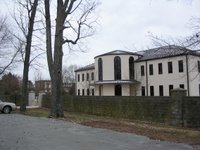
One time in the late 80's I was traveling with another friend of mine, Brian, on our way to Chicago. The first night we stopped at the Monastery of the Holy Spirit in Conyers, GA about twenty miles east of Atlanta.
Fr. Francis (originally a monk at Gethsemani and one of the founding monks of Holy Spirit, then in his 80's) met us at the Guest House door, "Will you stay?"
Anyone who has read Thomas Merton's Seven Storey Mountain knows this is what you expect to hear when you arrive at a Trappist monastery. There is a double meaning to the question..."Will you stay?" and join our community, "Will you stay?" in the guest house and finally since in the Rule of St. Benedict the stranger is to be welcomed as Christ...Will you stay? Lord as in "Stay with us Lord for the day is far spent."
We answered "yes" as in yes we'll stay in the guest house tonight, which we did and attended prayers and Mass--then left the next morning on our way to Gethsemani. We arrived in Gethsemani that afternoon (about seven hours later). No one greeted us or asked us if we would stay. There were a few other pilgrims wandering around but no monks visible. We were settled in the chapel for Vespers when the first monks began to emerge from the cloister and enter into the chapel. Brian leaned over to me and whispered, "Its the same guys."
Well not exactly. Driving toward Birmingham and away from Gethsemani I thought of my friend Peter who has been a big fan of the Trappists from way back. I knew that he had thought about entering the Monastery of Our Lady of the Holy Spirit at one timea and still made visits there frequently--I also knew that he had visited Gethsemani several times. His experience and mine of both monasteries knew that one welcomed strangers and the other saw them as an intrusion and to be fair because of Thomas Merton Gethsemani got a glut of strangers.
When I first stayed at Gethsemani the beds were very Trappist--really nothing more than a pallet with a two inch mattress on it. Years laters a beautiful, state of the art guest house was built that was more along the lines of mid range hotel. Now the Welcome Center--the times they are a changing.
I called Pete to share my views about the Welcome Center and I share them here because for the most part they were inaccurate as my return trip proved but they say a lot about how our minds process religious experiences. I told Pete:
"The first thing you notice when you walk in through the cloister wall and into the building is a coffin...it is open but empty. In some ways it is symbolic of immediately reminding you of your final end and asking you the question what am I here for? Several monks were available to answer the question."
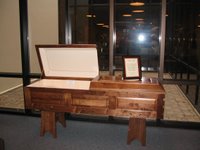
"Over the PA system there was an incessant crackling of flames--they made me think of the flames of Hell (another of the Last Things), when in fact a peak into the room to the left of the entrance showed that it was the Easter Fire being prepared and the flames providing the fire to illuminate the Easter Candle--symbolic of the light of Christ illuminating the darkness. The video featured the changing seasons...the crackling flames were replaced with crackling dead leaves falling from the trees surrounding the monastery, the barren trees introduced the funeral of a monk with living monks keeping vigil reading the psalms all night before the burial of their brother."
I told Pete that all of this left me with the impression that the Welcome Center was designed as a sort of funeral parlor and that unconsciously the monks were providing the guest with a modern morality play that the visitor was the staring player. Walking out of the Welcome Center I made my way toward the Chapel for Vespers--passing by another gate where the words "God Alone" were engraved. Long time readers of this blog will remember that this gate once graced the right hand column of this blog...the Gospel in two words, a reminder that after death all that matters will be God Alone...a reminder that in this life ultimately what matters is God Alone.
Then the Chapel and monks bending in unison at the waist singing "Praise to the Father, the Son and Holy Spirit both now and forever, until the end of the ages." punctuating the Psalms of praise and thanksgiving.
Death, Hell, Purgatory and Heaven all in a few minutes of each other. "Will you stay?"
No, not here anyway.
(Later my return to Getsemani later in the week and a more accurate description of the Welcome Center).
-Michael Dubruiel
Monday, November 01, 2021
All Saints Day - November 1
Tuesday, November 1, 2005
A Moment Frozen in Time - Michael Dubruiel
Advancing were youth holding signs "Silence and Kneel"…everyone obediently did so as cassocked men holding candles, one swinging incense advanced in front of a coped priest with humeral veil wrapped around the base of a monstrance held the Eucharistic Body of Our Lord aloft.
Those who have seen the movie "The Mission" with one of the best scenes ever filmed about the spiritual life will remember Jeremy Irons playing a priest holding the monstrance in the midst of battle all around him, himself falling and an indigenous man picking up the monstrance and continuing the procession. That is what popped into my mind as I instructed young Joseph to make the sign of the cross as Jesus passed in our midst.
I'll bet that when all is said and done, I'm not alone in this being a moment that will be remembered by all. What is more I have realized that these Catholic prayer moments are the solid foundation that most Catholics never forget--long after they have forgotten most of what they were taught.
There is a lesson here for those of us who try to pass on the faith to our children--introduce them to Christ, like disciples on the road to Emmaus let Christ the stranger teach them, open the Scriptures to them so that they might recognize him in the breaking of the Bread--that they may pick up his Presence and carry it through the streets of life where a battle wages.
Such catechesis is the lesson plan of saints--may all the saints pray that we might take up that charge!
